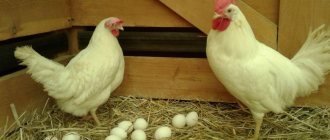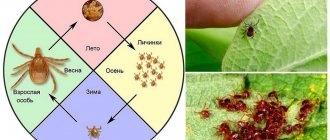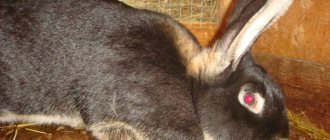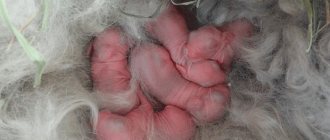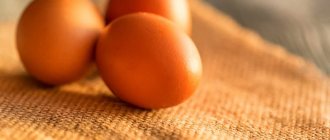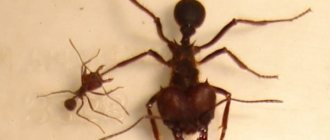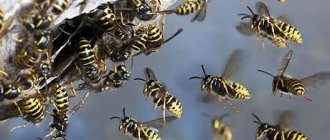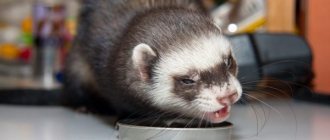- home
- Rabbits
- Breeding
11/09/2018 An important factor in the profitability of rabbit breeding is the reproduction of livestock. The farmer is obliged not only to feed and maintain rabbits, but also to know all the nuances of pregnancy, childbirth and raising young animals. It is important to create favorable conditions for the mother in labor in order to preserve all newborns and raise them into full-fledged representatives of the species. In this article we will talk about the birth itself and the features of caring for the mother and cubs in the first hours and days of the rabbits’ life.
How to recognize pregnancy
Not every mating ends with a positive result.
It is impossible to immediately determine whether it was possible to fertilize the female. Some rabbit breeders note that a successful attempt slightly changes the behavior of the rabbit. She begins to behave aggressively with males, selects fluff from her abdomen and eats food more actively. The effectiveness of mating can be reliably checked only after 2 weeks. The female rabbit, turning her head towards herself, is taken out of the cage onto a flat surface. If the animal tries to escape and behaves extremely restlessly, then you need to lightly stroke it on the stomach. Then the female is held by the withers with one hand, and the belly in the pelvic area is gently palpated with the other. Pregnancy is indicated by the presence of oval compactions measuring 1-2 cm, located in a chain in both horns of the uterus.
How to prepare for childbirth
It is necessary to prepare for the birth in time. Very often, proper preparation is not carried out, and this is a big mistake. Pregnant and lactating females need large amounts of food and water
Make sure your rabbit always has fresh water and food in her cage. It is very important to properly prepare the nest for birth. Firstly, before placing the nest in the cage of a pregnant rabbit, it must be thoroughly disinfected in order to protect the expectant mother and her offspring from infectious diseases
You can use hot water and a solution of potassium permanganate for disinfection. The nest should be thoroughly cleaned with a brush. If you used a disinfectant, you will need to rinse the cage with hot water after the disinfectant has dried to prevent the baby rabbits from licking it off. Usually the nest is placed with the female 4-5 days before the birth. If you place the nest too early, the female rabbit will most likely use it as a toilet. If the nest is laid too late, she will not have time to get used to it. The female needs time to get used to it. For the nest, place fresh, clean hay in the cage, which must be checked for the presence of foreign objects. It is best to use soft hay. A little hay should be put in the nest, and the rest should be scattered around the cage so that the rabbit herself can arrange the nest as she wants. However, some rabbits really don’t like it when hay is placed in the nest; they will deliberately throw it out of there. Rabbits love silence, especially for pregnant rabbits. Warn your family not to make noise near the cage or make sudden movements. Also, if possible, try not to transfer the rabbit into a new cage, especially if she is already in the late stages of pregnancy. A change in her usual environment can frighten her. Before the rabbit goes into labor, it is better for the owner to have a good rest, because when the rabbit is ready to give birth to cubs, she will no longer have to sleep. Many problems during birth can be avoided by checking your rabbit hourly. If you see that she is about to give birth, it is better to approach her every 10 minutes. Do not plan trips, do not make other plans if your rabbit gives birth on these days. The female may need your help and care. Hourly checking can save the lives of babies if they are born not in a nest, but on the floor of the cage. It may also happen that the rabbits are too large and the female rabbit cannot give birth to them without outside help. Developmental conditions during the uterine period significantly affect the viability and breeding qualities of rabbits. Therefore, the pregnant rabbit needs to be provided with adequate nutrition, a sufficient amount of fresh water, and kept in a bright room. You should not give her moldy and frozen food, as well as antibiotics. You need to treat a pregnant rabbit especially carefully and calmly. It is necessary to avoid anything that can cause her fear - in a panic, the rabbit makes sharp, unexpected leaps that can result in a miscarriage. If pregnancy is combined with lactation, then her diet must be composed most carefully.
How to make a queen cell with your own hands
To arrange a place for a future rabbit’s nest with your own hands, you need to fulfill several conditions. First, the cage must be large enough to accommodate the queen cell. Some rabbit housing designs include a nest. However, in most cases the animal's cage may be too small for breeding.
For the queen cell, you can use a special closed box with one round entrance. The size of the crate should ensure that the mother rabbit and her babies can fit in without any problems. A small queen cell can lead to accidents: the female can accidentally crush the cubs if she has no room to turn around.
The entrance to the box should be located high so that the rabbits do not get out of it in the first few days. Sometimes an ordinary box with an open top can be used as a queen cell, but the walls must be high enough so that the babies do not fall out.
You can make a queen cell with your own hands; for this you use good wood. Oak, maple or birch will do. It is undesirable to use fruit tree wood for these purposes: rabbits may develop allergies.
Queen cell for rabbits
Little rabbits are born completely helpless and naked. In the first few days, their life depends on how well the queen cell was insulated. It is necessary to ensure that the fluff that the female tore for the nest is fresh and not matted. Otherwise, there is no need to disturb the animal: careless actions can scare it away.
The mother liquor should be in a dry, warm place without drafts. The female rabbit is demanding when choosing a place for a future nest and will not tolerate poor conditions. You need to make sure that the female likes the place of the box: when the female rabbit tears up fluff for the nest, she often does not know how to stop, and if she doesn’t like the construction, she can destroy everything and start over. This also affects the rabbit herself: the animal can get so carried away by the changes that wide bald spots appear all over the body.
How long before giving birth does a female rabbit begin to tear up fluff?
If a female rabbit tears up the fluff to lay it in the nest (in other words, in the queen cell), this is a clear signal that labor will begin soon, literally in a few days. Most mother rabbits are good and conscientious mothers. Having plucked warm and soft fluff from her belly and chest in advance, the pregnant rabbit places it in a warm nest. This makes it possible to provide the newborn offspring with a fairly comfortable temperature and does not allow them to freeze, since the baby rabbit uses the mother’s down as a kind of blanket.
If, according to your calculations, the litter is already very close, and the female rabbit does not want to build a nest, you need to pluck out her fluff with your own hands and spread it in the queen cell.
The main reasons why a female rabbit does not tear up the fluff before giving birth and refuses to make a nest are:
- underfeeding;
- inexperience of the female (first pregnancy);
- the animal is stressed or frightened by something.
If a female rabbit, pregnant for the first time, is preparing to give birth, but does not prepare the nest before giving birth, she needs to be monitored especially carefully. Often such “mothers” scatter the born babies throughout the cage and even eat the offspring.
When a female is carrying future offspring, the following rules must be observed:
- there should be no drafts in the cage of the expectant mother;
- the cage should be protected from sharp and loud sounds (for example, dogs barking and the roar of a tractor) and access to it by strangers should be limited;
- if the birth time occurs in the summer, it is better to darken the cage a little;
- the temperature inside the cage should not be higher than 33 degrees;
- To prevent newborn babies from becoming infected with coccidiosis, you need to carefully monitor the cleanliness of the maternity ward and change the bedding regularly, once every two to three days.
With proper care and compliance with the rules listed above, childbirth usually goes quickly and easily. Their duration ranges from 10 to 15 minutes, occasionally (in especially large rabbit breeds) they last up to one hour. One litter can contain from one to twelve cubs.
This depends on many external factors: the age of the rabbit, the individual characteristics of her body, breed, diet, and so on.
Females usually give birth before dawn.
This is due to the natural characteristics of these animals: the rabbit is a very timid animal, and at night it is much quieter and calmer than in the daytime. The end of childbirth is characterized by a hollow abdomen and swollen nipples, and the female herself becomes much calmer. After birth, you need to carefully examine the baby rabbits and remove dead (if any) or sick babies. Frozen rabbits need to be warmed up.
Some females (especially during the first litter) scatter their cubs or separate them. In this case, the rabbits need to be taken away from her for one day. There is a possibility that she is in heat again and needs to be covered again. After a day, the mother usually calms down and accepts the offspring. While the cubs are weaned from their mother, they should be warmed up independently.
How to do it is very simple: pour warm water into a container (not hotter than 45 degrees) and wrap it in a towel. Place the baby rabbits on top of it and cover them with down. The towel should not have holes or snags, otherwise the rabbits may get caught on them and get damaged. Drop a small amount of condensed milk diluted with warm water into the mouth of each newborn. Cow's milk cannot be used, since it is very different from rabbit milk in composition.
After returning the children to the mother, examine her nipples. They should be swollen. Provide your rabbit with fresh water and adequate nutrition. Its milk productivity depends on this.
You cannot spy on the female in the nest, so as not to irritate the animal. She feeds the cubs once a day. The female never sits with the young rabbits in the nest all the time, since her characteristic smell is different from how the baby rabbit smells. This is an instinct to protect against predators (so that they don’t smell the babies).
12 hours after the mother has placed her babies in the nest, open the box and inspect the offspring.
If the bellies of the rabbits are dense and their skin is shiny, this means that they have enough milk. If the cubs' skin is cold, their stomachs are sunken, and their skin is dull in color, mother's milk is not enough for them. In this case, you need to either transfer them to artificial feeding or place them with a milkier female.
Are you here
Questions can only be asked after registration. Please login or register.
Dear forum users, tell me what is happening. rabbits refuse to breed. I am a novice rabbit breeder, I bought a pair of silvers and a pair of Californians, on 11/23/14 I brought together a pair of silvers, and as expected 12/23/14 + - I waited for an increase for two days. The female, as usual, plucked the fluff, built a nest and then oops, there are no signs of devouring the rabbits, no blood was found, waited 5 days, sent to the male, he covered her again, didn’t understand anything, well, I’ll wait again, Hope was for a couple of Californians who were brought together on 12/07/14 that is, on 01/07/15 the baby rabbits should appear, BUT even here the female does not tear up the fluff, does not make a nest, tell me what to do. Females are 5 months old, males are 6 months old. Good food, clean water every day. the room temperature does not drop below + 5 degrees.
options: ate the rabbit ate (dragged away) the rat ate (dragged away). other predatory animal variant with Copperfield is not considered.
they couldn’t evaporate either
The chain-link had rotted on the floor and the little ones' paws had fallen into the hole. The cat pulled it out with its paw and devoured it. The pensioner did not immediately notice the hole, but only when baby rabbits began to fall into it. Moreover, more than one litter was injured. And he burned the cat down to its skins in a secluded place. And although the hole was repaired, I kept checking under the cages until I got a stump.
BUT even here it’s a mistake, the female doesn’t tear up the down, doesn’t make a nest, tell me what to do. Mine may not be correct, but they also never do it in advance; I always make something like a nest out of hay myself. In the evening they still eat it (my nest) and in the morning, lo and behold, they’ve finished it and the little rabbits are already covered in fluff. when they have time.
This year we also have a problem with rabbits. They are steaming, but the time is approaching, but the rabbits are not there. Although they have brought rabbits more than once before. They don't even tear the fluff. The cages are new, so there is no possibility of cat mischief.
If you work, you have no time to live. If you don’t work, you have nothing to live on.
The female, as usual, plucked the fluff, built a nest, and then oops, the baby rabbits have no traces of being eaten, no blood was found, waited 5 days, sent to the male
Some females do this 10-12 days before giving birth. Advice can be given if you have been keeping Clorey before me (I have been since I was 8 years old, that is, already 38 years old).
_____________________________________________________ You can expect anything from these bees. V.P. (Winnie the Pooh)
Look more closely for traces of blood; if not, it’s a false pregnancy. And this happens from overfeeding, obesity. Coliphs are generally very prone to obesity. I even feed pregnant women hay and a little oats, only when it’s over, I start feeding them to their heart’s content.
Advice can be given if you have been keeping Clorey before me (I have been since I was 8 years old, that is, already 38 years old).
What a serious guy
What can I tell you, Mikhail, there are a lot of advisers here (on the forum), but the advice is not always practical and correct. So I’m not advising, but simply sharing my experience. Let's start with the fact that you introduced young females into mating, but they do not always want to cover themselves the first time. The males, as I understand it, are also young and untested. Then, did you introduce females to one male on the same day? From my own experience, it is better to introduce females to young males every other day, in order to avoid idling due to the fault of the male. Now for the nest. Alexey correctly gave an example: different females have different maternal qualities. A female may think that she is pregnant, build a nest, pick fluff and not give birth, while another, as Alexey writes, eats hay from the queen cell, and the next day gives birth, and then picks down. By the way, caliphs can still give birth, wait, pregnancy may be delayed, I had up to 33 days. Outside interference, for example in the form of rats, cannot be ruled out either. And Mish’s advice is this. Read about rabbits, watch them, think and experience will come. Good luck! PS. I apologize if I missed some details and aspects.
Today we were advised to forcibly mate the female. The husband laughed - he worked as a pimp. He held the female and lifted her tail, and the male had already done his job. Before this I let him in, but the female didn’t want to. Now let's see what comes of this.
If you work, you have no time to live. If you don’t work, you have nothing to live on.
Nest box
2–5 days before the birth, a nesting box is installed in the cage and favorable conditions are created for the rabbit and newborns: the bedding should be dry, twilight and a calm environment in the cage is desirable. The cage must be reliably insulated from low temperatures and drafts, the nest box must be of a suitable size so that the female and her cubs can easily fit in it. If these requirements are met, childbirth outside the nest is excluded. But if it did happen, it means that something was not taken into account. For example, if the room temperature is 20 °C, and the cage has a solid bottom, then the female rabbit will probably give birth outside the box. A high-quality nest box is one of the important indicators of a successful birth. There are many options, but it is better to make an insert box that can be easily removed from the cage when the rabbits reach 25 days of age and if the room temperature is above 20 ° C and there are no drafts.
High-quality materials for nest construction
Above in the article it was mentioned how many days before a female rabbit begins to pull out fluff and wool, preparing building materials for the nest. In addition, beginning rabbit breeders should be able to choose the right dried grass for arranging the queen cell.
A suitable material would be high quality hay without mold or parasites. It is not recommended to use herbs, since such components cause allergies in born babies.
Behavior is considered to be a signal of approaching birth when the female rabbit begins to put straw, hay, and fluff in one corner. From this moment on, control over the pregnant animal should be strengthened. In addition, the time has come to prepare a comfortable place for giving birth.
It is not recommended to change the cage during the gestation of the rabbits and until the very moment of giving birth. The female rabbit should give birth in a familiar, calm environment. 2-3 weeks before giving birth, it is recommended to thoroughly clean and disinfect the house, preparing it for the mother rabbit and her babies.
External signs of approaching labor
After mating, the female is placed in a separate cage. It is not advisable to keep her with a male to prevent repeated mating. The rabbit's uterus is two-horned, so a second fertilization is possible. Cubs from the second pregnancy are usually stillborn.
To make sure that the mating of the animals was successful, a week after mating, the female rabbit is again placed with the male. If the female behaves aggressively and allows the male to approach, it means she is pregnant.
The expectant mother is fed food rich in proteins, vitamins and minerals. Slightly dried green grass or hay, vegetables, root vegetables, grains and legumes, mixed feed - all of the highest quality, without rot and mold. The diet is increased approximately 1.5 times. At the same time, the female should not be overfed. In addition to a separate cage, they will equip a queen cell - a nest in which the female rabbit will give birth, and the cubs will spend the first weeks of life. The owner prepares a box inside the cage or builds a separate “room”, and the female rabbit makes a nest out of fluff.
The approach of childbirth is signaled by a change in the female's behavior. Either she becomes restless and even aggressive, or, on the contrary, timidly hides in the far corner of the cage
A few days before an important event in life, the expectant mother begins to insulate the nest. Pulls out fur on its chest, belly and lines the bottom of the queen cell
When the female rabbit begins to build a nest, there are 2-3 days left before giving birth. True, females also do this during a false pregnancy.
You can identify a pregnant female in the second half of pregnancy by carefully palpating the abdomen. It is better for an inexperienced breeder not to do this, so as not to harm the babies.
The rabbit is placed on her back and her fingers are gently moved along her lower abdomen. The animal's muscles should be relaxed. The embryos can be felt as a chain of small, dense balls.
A rabbit's pregnancy lasts from 28 to 34 days. The length of the period depends on the breed and the number of embryos. Large rabbits bear babies longer than representatives of dwarf breeds. Childbirth begins earlier if there are more than 8–10 rabbits in the litter. Delivery too early results in stillbirths. During pregnancy, the female's instinct to preserve offspring awakens. She becomes even more skittish
Therefore, it is important to provide the expectant mother with a quiet and peaceful place, away from noise sources. Miscarriage can occur due to any stress, strangers or other animals near the cage, a sharp sound and even bright light
If the rabbit has made a nest, but does not give birth, you need to carefully examine her.
- If there are signs of pregnancy and the due date has passed, call the veterinarian. The female may not be able to give birth and will need a caesarean section. There is no time to waste here, otherwise both the cubs and the mother will die.
- If the gestation period is short, 2–3 weeks, and the female has collected fluff but has not given birth, a false pregnancy is possible. In a few days the animal will return to normal and forget its “fantasies.” But of course she won’t have any rabbits. Experienced farmers claim that after a false pregnancy, the female can no longer bear healthy offspring. It is better to exclude such animals from breeding and not allow them to mate.
Peculiarities of caring for a fledged female and offspring
The key to successful replenishment of the rabbit population is proper care of the young mother and newborns.
- Enhanced and balanced nutrition . To produce milk, the diet of a nursing female must contain a lot of protein, vitamins, and minerals. It is important that during this period the young mother’s diet includes fish or meat and bone meal, chalk, and salt. You can buy special vitamin and mineral supplements at the pet store. The expectant mother is fed only high-quality and fresh products. Remember to wash root vegetables before feeding them to your rabbits.
- Drinking water at any time of the day. The female loses a lot of fluid, so the water in the drinking bowl should always be clean and fresh.
- Temperature regime. In winter, the cage with newborns is additionally insulated. The comfortable temperature for babies is considered to be +18 °C. In severe frosts, it is better to keep the cage with newborns indoors. In summer, rabbits are kept at a temperature no higher than +23 °C and good ventilation. Remember, rabbits do not like drafts.
- Peace, quiet and safety . The cage with the young mother and cubs is located away from sources of noise, unexpected sharp sounds and bright light. Strangers should not appear near the nest, look at the baby rabbits, or even pick them up. If the female believes that something is threatening her offspring, she may refuse to feed the children.
Toxicosis
Early pregnancy in a rabbit can sometimes be accompanied by toxicosis. Manifestations of the body’s negative reaction to pregnancy can be weak and have almost no effect on the normal rhythm of the animal’s life. However, in some rabbits the toxicosis is very pronounced, and then the help of a veterinarian is often required. Toxicosis that requires medical treatment manifests itself as follows:
- Frequent urination while maintaining the normal volume of urine output or its slight decrease;
- Breathing disorders associated with difficulty;
- Disturbances in the functioning of the central nervous system;
- Severe depression;
- A noticeable odor of acetone from the mouth.
If severe toxicosis occurs, which does not go away within 3 days, it is necessary to show the pregnant rabbit to a veterinarian.
Frostbite
Rabbits experience frostbite as a result of prolonged exposure to low temperatures. As a rule, pets' paws and ears are most susceptible to hypothermia. The highest chance of developing frostbite is in rabbits after giving birth, especially in cases where the nest is poorly insulated and the temperature around is low.
Signs:
- the first degree of frostbite is characterized by swelling and soreness of the affected area;
- the second is characterized by the formation of blisters with a light liquid inside, which burst within a few days, and in their place appear ulcers that do not heal for a long time;
- necrosis of frostbitten areas of the skin, wrinkling and drying of the tissues underneath is a sign of third degree frostbite.
Help:
- move the animal to a warm room, let it dry and lubricate the affected area of the body with camphor ointment (1%), pork fat or petroleum jelly;
- open the blisters, remove the liquid and lubricate the affected areas of the skin with camphor, zinc or iodide ointment;
- Remove dead tissue and treat the resulting wound like any other.
How to find out if a rabbit is pregnant She constantly digs in the cage, this could be a sign
Green tea
Connoisseur, closed 5 years ago
She-wolf
Guru5 years ago
Pregnancy in rabbits lasts 28 - 35 days, but most female rabbits kitten at 31 - 32 days. Rabbits can become pregnant as early as 3 months old, and they can have offspring even when they are considered old. If the female rabbit has not met a male or she is sterilized, a false pregnancy may occur due to a hormonal imbalance. On the 25th day, the rabbits in the mother’s belly begin to move. This is a sure sign that we should soon expect an addition to the family.
If you know the date, that is, the mating was planned, then you begin to prepare on the 27th day of pregnancy. If you cannot determine the exact date, start preparing as soon as you notice fruit movement.
The rabbit's behavior changes. Some become aggressive, others, on the contrary, are too shy and want to hide in a hole. Still others behave as before. It all depends on temperament.
As the due date approaches, the female rabbit begins to tear out the hair from her chest and abdomen and collect it in one corner of the cage. She begins to circle around the cage with a bunch of hay or wool in her teeth. This is a sure sign that she is building a nest. For some females, the desire to build a nest arises 3-4 days before lambing, others begin this immediately before lambing, others do not build nests at all or start building after lambing.
She-wolf
Guru5 years ago
https:// _alehandritta. _narod.ru/photoalbum. _html extra!
Problems with nest construction
If you follow the rules of caring for the animal, the female bears offspring for a month. 5 days before giving birth, the female rabbit makes a nest, sometimes this does not happen for the following reasons:
- nutrition – lack or excess of food;
- stress – the rabbit’s body reacts this way to many factors;
- queen cell - its incorrect structure or absence.
One of the reasons that the female rabbit does not tear out the fluff to create a nest is stress. These mammals are one of the most timid animals. A pregnant animal experiences a feeling of fear more often
Because of this, you should not make noise near the rabbit; you should handle the animal carefully and protect it from possible stressful situations
Considering the characteristics of the nervous system of rabbits, it is important to provide comfortable conditions during childbirth - silence, peace, lack of lighting
When cleaning the nesting part of the cage, avoid noise, otherwise it will cause miscarriage. The female should not be picked up, because this is additional stress for the animal. You should not enter the rabbitry unless necessary, so as not to disturb the animal.
One of the main reasons why a female rabbit does not make a nest is an incorrect diet. The food should not contain nitrates or low quality products. Feed is given on a schedule so that the load on the digestive tract is reduced and the animal does not worry. Low quality feed should not be included in the animal’s diet. Because of this, the female begins to get sick and there is a risk of miscarriage. Her menu includes products containing vitamins and microelements.
In order for the female to prepare the nest box in time, follow these rules:
- three days before birth, rabbits reduce the amount of food in their diet;
- the animal should always have a container with fresh water;
- During this period, it is worth giving the animal more green food.
One of the reasons that the female does not pluck fluff is the improper arrangement of her home. A queen cell is a small box
It is important that the animal does not feel cramped in it. They make it with their own hands
The entrance to the rabbit's home should be round in shape and slightly raised above the floor so that the rabbits cannot crawl out.
The mother rabbit needs a queen cell to successfully feed her offspring.
You cannot change the queen cell 2-3 weeks before giving birth, this causes unnecessary anxiety in the female. The birth of offspring should take place in a familiar environment. About 2 weeks before birth, the cage is washed well, and the queen cell is filled with hay. If the rabbit did not tear up her down, the nest box is not built correctly. Its size depends on the animal. In winter, during frosts, it must remain warm, and in summer, cool.
If a female rabbit tears up fluff for the nest, this means that offspring will be born in a few days. If the animal does not do this, you will have to tear out the fluff with your own hands and place it on the bottom of the box.
In order for the female to tear down the fluff and prepare the nest, the following rules are followed:
- the nest is placed in a place protected from wind and drafts;
- the animal is isolated from noise;
- in summer the cage is shaded;
- To prevent the offspring from contracting coccidiosis, the litter needs to be changed frequently.
If you follow the rules of caring for a pregnant female, calving takes 10-15 minutes. For larger animals this takes an hour. In one litter, from 1 to 12 individuals are born. More often than not, breeding begins early in the morning. This is due to the fact that these animals do not like noise, and night is the quietest period. The end of the litter can be seen by the swollen udder, the belly becomes sunken, and the female rabbit becomes calmer.
After the end of the birth, it is necessary to examine the offspring and remove the dead rabbits
It is important to warm those who are frozen
Female rabbits build a nest so that the offspring receive enough warmth and are protected. If the female does not tear her down, she should be closely watched. Such individuals are capable of scattering offspring throughout the cage
If the female has divided her litter, it is important to take all the cubs away from her for one day. After a while she will become calm and accept the cubs
During this period, it is worth ensuring good heating of the rabbits' nest. You can do this yourself. Warm water is filled into a bottle, wrapped in a towel and placed next to the babies. From above, the offspring are covered with rabbit fluff, which the female tore. The size of the box depends on the number of offspring.
A day later, the cubs are returned to the female. Her udder should be swollen, during this period she needs good food and access to clean water, this affects her milk production. Usually the female rabbit does not sit in the nest next to the cubs; she feeds the offspring only once a day.
Why doesn't a female rabbit make a nest before giving birth?
The lower the ambient temperature, the more fluff the pregnant female tears up to build the queen cell. Sometimes the female rabbit does not make a nest before giving birth. There are three probable reasons.
- Poor or insufficient nutrition. The lack of certain nutrients does not give confidence that the rabbit can feed the cubs. Therefore, she abandons the brood in advance. A pregnant female is fed 3–4 times a day. The daily ration is increased by half. If the rabbit did not make a nest and gave birth, you need to help her. To remedy the situation, gently tug a little fluff on her belly and chest. It is permissible to add cotton wool to the queen cell, but under no circumstances should you line the nest with the hair of other animals. The rabbit will be afraid of someone else's smell and may even show aggression towards the newborns.
- Lack of water . If there is no drinking water in the drinking bowl or it is stale, this also serves as a signal to the expectant mother that the offspring will not survive and should be disposed of immediately.
- The queen cell is too tight or absent . If the female does not create the necessary conditions for raising babies, she will also not feed the newborns.
Take care of tender babies
So, the births have already taken place... Now the owners need to carefully monitor the behavior of the suckling rabbits. If two-week-old babies begin to leave the nest and look for food, it means that the female has little milk. In high-milk rabbits, the offspring feed exclusively on mother's milk for up to 18-20 days. The female needs to increase the diet taking into account the offspring, especially from the time when the rabbits begin to leave the nest and try the food that their mother eats. Some feeds are best given in crushed form. The hay in the feeder should have a large number of leaves, and carrots are preferable to beets in diets. In the summer, baby rabbits grow best on good, high-quality greens.
The period when the young rabbits leave the nest is critical in the development of the young. Right now, children are especially at risk of getting sick and dying.
As you know, only after reaching 28 days can young animals be fed concentrates and root vegetables. In newborn rabbits, milk teeth appear on the 21st day of intrauterine development, and their replacement occurs during the first month of life. If at this time babies are given coarse hay, beets, whole grains and even granulated feed, then they may experience non-infectious stomach disorders (catarrhal inflammation). Therefore, rabbits up to a month will benefit from only highly nutritious, vitamin-rich and easily digestible food.
Feed your rabbits “baby porridge” for babies and vitamin mash, and also drink milk (fresh or based on a milk powder substitute for animals). You can also prepare a special milk mash by adding crumbly (not granulated) feed into the milk, or make oatmeal jelly with milk or skim milk with the addition of fish oil, 0.5 g of the latter per animal per day. And only gradually, within 10 days, transfer the young animals to the established norms and diets.
But it also happens. Established feeding standards are maintained, rations are strictly observed, but the baby rabbits still die. We must look for the causes of the trouble. And there can be many of them. The most common mistakes made are:
due to errors in breeding technology, rabbits are often born weak and with further rearing there is an increased mortality rate among them, therefore it is very important to recruit breeding stock from high-milk females;
there may be poor quality food in the feeders (expired shelf life, moldy or dusty hay, wet grass); Excess beets, tops, root vegetables, cabbage, unripe alfalfa and clover in the diet are harmful to rabbits; poisonous grass and sprouted potatoes are dangerous;
there are errors in keeping rabbits (drafts, cold, dampness, large accumulations of dust, dirt and manure both in cages and in rabbit hutches);
There are animals on the rabbit farm that are sick with infectious diseases.
Change feed in animal diets carefully and gradually. A completely acceptable option for feeding rabbits is to use the same feed throughout the year.
At the same time, the unfortunate transition periods for animals (spring and autumn) disappear. For example, you can constantly give rabbits feed and hay or grain mixture and legume hay. For any type of feeding, water should be in the cages at all times.
How to cure a false pregnancy in a rabbit
Most often, females who have experienced false pregnancy do not produce healthy offspring as a result of subsequent successful pregnancies. There are several ways to rid an animal of pseudomaternity:
- Kill the animal. This method is most suitable if you keep rabbits solely for the sake of offspring. If the target raw material is skin or meat, the female rabbit can be placed in a separate cage from other individuals and raised until the necessary products are collected from her. In this case, there is a possibility of complications in the health of the reproductive system of the mammal.
- Sterilize the female rabbit. Such a surgical intervention will save the rabbit from possible side effects of false pregnancy in the form of uterine and mammary cancer, ovarian suppuration or endometrial hyperplasia. If this method is chosen, the patient's reproductive organs are removed. After the operation, the female’s hormones calm down, she becomes calmer, and the false maternal instinct no longer occurs.
- Wait. False pregnancy ends within 15 days. During this period, the female manages to build a cozy house. You should not break it, otherwise the animal will start all over again. In such situations, you should observe the behavior of the female rabbit and not interfere as long as the actions do not harm her health and the comfort of other members of the herd.
What to do if a mother rabbit scatters her babies
We have figured out the main reasons why a mother rabbit throws her babies out of the nest. Now let's try to talk about how to deal with this phenomenon. First, you need to properly prepare the breeding cage. She should not stand in a draft. The bedding should be made soft so that the female can find enough material for bedding. A week before the expected birth, the cage should be thoroughly washed. If the rabbit does not arrange the nest herself, you need to do it for her. In late autumn, it is better to refrain from mating to avoid giving birth during the coldest winter months. Moreover, in October-November rabbits have low sexual activity.
When the female rabbit becomes restless and sexually aroused, she needs to be transplanted into a cage with a male. She will calm down and begin to show interest in her bunnies again. Babies should be examined after birth and dead and weak ones should be removed. This must be done with clean hands, washed with laundry soap, so as not to leave your own smell on the rabbits. There is no need to look into the nest and touch the cubs unless absolutely necessary. If you do this too often, they will pick up someone else's scent and the rabbit will not recognize them.
If the question of why a female rabbit throws out her young cannot be resolved, the young animals can be placed with another female. To do this, the age of all rabbits must be the same. In order for someone else's rabbit to accept the babies, she is placed in another cage for a while. The cubs are pulled out with clean hands (you can rub your palms with wormwood). After this, they are thoroughly cleaned of fluff and bedding and placed in the nest. It is advisable to place the baby rabbits in the center, between the siblings. After about twenty minutes, the female is returned to it, during which time the rabbits have already managed to pick up the smell, and the foster mother cannot distinguish them from her own.
When there is no suitable female, you can try to raise the rabbits yourself. Whole cow's milk or a mixture of it with condensed milk in a 3:1 ratio is suitable for feeding. The rabbits are first fed from a pipette, 4-6 times a day. After twenty days they can drink from a nipple, and from a month onwards they lap perfectly from a saucer. You can watch the video on the Internet to see how to properly feed baby rabbits.
False pregnancy
Sometimes the reason why a female rabbit does not give birth is a simple thing - there is simply no one to give birth to her.
Conception does not occur, but the follicles of the eggs burst, releasing the corpus luteum. It provokes the production of progesterone in the rabbit’s body, a hormone characteristic of real pregnancy.
In these cases, the female is also engaged in the construction and arrangement of the nest, plucks out the fluff on her chest and belly, collects and puts it and straw in a place for the “future offspring.” At the same time, her behavior becomes aggressive, she boldly defends the nest from everyone, including the owners. In these cases, it is worth limiting yourself to minimal intervention. You should not try to remove the nest from the cage, as this may get you bitten. If the rabbit was too diligent in tearing out her fluff and caused damage to herself, the wounds need to be disinfected (for example, with hydrogen peroxide). Make sure that the wool does not get into the animal’s digestive system.
Usually this process begins a few days before the birth, that is, 27-29 days after fertilization. If the female rabbit began construction on the 17-18th day after mating, most likely there are no offspring in her womb.
In some cases, females begin to mark everything - the territory, other domestic animals and the owner himself.
It is during this time that the function of the corpus luteum fades away. If this happened once and does not happen again, you don’t have to worry too much.
The last resort in such cases is sterilization, which allows you to reduce the hormonal levels of the rabbit. This is practiced quite rarely and is possible in the most extreme cases, for example, if there is a risk of sepsis in the uterus. The operation must be entrusted to a highly qualified specialist.
Additional nuances when building a nest
In some cases, the female tears the down so much that she can accidentally injure herself with her sharp teeth. Such wounds are treated with a 3% hydrogen peroxide solution. If this happens, the animal may stop making the nest and feel uncomfortable for a while. However, usually by the time the rabbits are born, they still finish building a shelter for the babies.
If the female was unable to make a nest, an artificial one needs to be recreated. The hay is kneaded with hands dressed in damp disposable gloves. After this mass is mixed with animal fluff and placed in the queen cell. There is no guarantee that the female rabbit will like such a replacement, but still the chance of a successful litter increases. If the female refuses to give birth in an artificial rabbitry, then you should be prepared. Immediately after giving birth, the babies most likely need to be fed to another rabbit, otherwise they will die.
Main reasons
So, first you need to deal with two questions. The first is when does the female rabbit tear up fluff for the nest? According to all the rules, she should begin preparing for construction approximately 3-5 days before the start of the litter. The female rabbit builds a nest quickly, especially if there is a sufficient amount of hay.
This procedure is a signal to action for the rabbit breeder. Now he has to check every evening to see if the deadline has come.
But how to determine deviation? Here you need to take into account that pregnancy in rabbits lasts about a month. If 27-28 days after mating she does not begin to prepare the nest, it is time to take action and urgently correct possible shortcomings.
So why might a female rabbit refuse to make a nest? Reviews from rabbit breeders highlight three main reasons:
- Stress;
- Lack of diet;
- Unequipped or missing queen cell.
Each of the three options must be prepared in a timely manner, or corrected as quickly as possible.
How to properly arrange a queen cell
3-5 days before the expected due date, it is recommended to install a nest box and fill it with straw, sawdust, hay, and moss. The size of the structure depends on the breed of rabbits. The box should have one round entrance located at a height of 2-3 cm above the floor.
This arrangement of the queen cell helps retain heat, and the raised entrance prevents the rabbits from spreading. It is believed that birch, oak, maple are suitable for making mother liquor, and fruit trees cause allergies in rabbits. Read more in the article “How to make queen cells for rabbits.”
From the very beginning, you should worry about insulation, the absence of drafts, and the comfort of the rabbit “house”. Such a building is positively perceived by the pregnant rabbit, who most often builds a nest inside a protected, cozy space.
If the female does not find a suitable place for a nest, then she will not tear off her fluff, collect straw and hay, and pile it at one point. In this case, you should pluck out the fluff on the rabbit’s belly and spread this material inside the queen cell. During and after childbirth, you must not disturb or frighten the animals, so you must act carefully.
Diet problems
The first point that leads to a rabbit’s refusal to fulfill her maternal duties is an incorrectly composed diet. If a female does not have enough substances to preserve and give birth to any healthy rabbits, she subconsciously gives her body a signal to refuse and does not build her nest.
This will lead to the fact that the born offspring of rabbits will be exposed to the cold and die immediately. Such an outcome is unacceptable in any scenario, and must be avoided at all costs.
In terms of diet, this concerns the correction of three points:
- Diet volume;
- Regularity of nutrition;
- Saturation of products with necessary substances.
The diet of pregnant rabbits should have a full range of vitamins and microelements. Food should be given juicy and fresh. The exception to the last point is green food for rabbits, which is always given a little withered. But feed must be selected especially carefully.
The amount of food consumed by pregnant rabbits is approximately 150% of the norm. Less is not enough, more means the risk of obesity and the birth of sickly rabbits. The same applies to regularity of nutrition. During this period, the feeding regimen should be made most strictly measured. This will make the digestion process much easier for the rabbits.
Diet of a pregnant female
The feeding diet of rabbits must be complete, high-quality and balanced; the feed should not contain products containing nitrates or simply of poor quality.
This is especially important when feeding a pregnant uterus. Her diet and feeding regime need to be given maximum attention.
Feeding should be given strictly according to a schedule to eliminate moments of anxiety for the expectant mother and reduce the load on her digestive system.
The health of the future offspring is established precisely during gestation, therefore, in order for future cubs to be born strong and viable, it is necessary to ensure that the female does not get frozen, rotting, moldy or rotten food into her food. This can lead not only to illness in the pregnant rabbit, but also to an increased risk of embryo death in her womb.
Eating green foods increases fertility rates. In addition, the diet should contain foods that serve as a source of the required amount of microelements and vitamins.
A week before giving birth, the amount of food should be reduced so as not to overload the gastrointestinal tract.
It is important to provide the pregnant female with constant access to fresh and clean water. The drinking bowl should be washed daily, and after each wash, dry it in the sun.
This approach will prevent the occurrence of infections.
A good healthy female rabbit always prepares her nest.
A possible reason that the rabbit gave birth, but did not build a nest before that, may be a deficiency of vitamins and moisture in the body.
It is the lack of drinking that inhibits the development and growth of the mammary gland, which leads to insufficient milk production in the female. A few weeks before the planned due date, the female rabbit's mammary glands should be slightly swollen.
How to find out if a female rabbit is feeding her offspring
Rabbits fed by their mother have round, dense bellies, while hungry ones have sunken bellies. The skin of hungry rabbits will lie in folds due to dehydration of the body. They weaken, hardly respond or respond very sluggishly to your touch. If the babies are weak and have signs of dehydration (dehydration), it is better to seek help from a veterinarian. You can put a drop of honey or fruit jam in the baby rabbits' mouths to raise their blood sugar levels and keep them there until you can get to the vet or be able to provide mother's milk again. If the babies are hungry, check to see if the mother has enough milk. The nipples should be slightly swollen and free of hair: the female rabbit rips out some hair from her chest and belly not only to line the nest with it, but also to make it easier for the babies to get to the nipples. When you lightly press the nipples and imitate sucking movements, a small amount of milk or clear liquid should appear. If the female is lactating, return her to the babies and let her calm down. Check the baby rabbits the next day to make sure the mother has started feeding them. If the female rabbit is not producing milk or has not done anything to build a nest, take her to an experienced veterinarian immediately. Your veterinarian will likely give your rabbit a small dose of oxytocin (a drug that stimulates the mammary glands). The mother rabbit should begin feeding within the next 24 hours. If you are concerned about whether the mother rabbit is feeding her babies on the first day of their lives, do not do anything until the next day. Some females begin only in the evening of the 1st day or even on the 2nd day. If almost two days have passed and you see that the babies are still hungry, contact your veterinarian. Oxytocin does not work if more than 48 hours have passed since the birth. While waiting for the veterinarian to arrive, you can let the babies suck on the female's mammary glands, as sucking movements can sometimes cause milk to appear. The mother rabbit feeding her offspring stands, and the babies lie on their backs under her.
The process of rabbit birth (birth)
Births in rabbits usually occur at night. Usually the rabbit gives birth on her own and does not need outside help. Instinct tells her when to gnaw the umbilical cord, eat the afterbirth and lick the newborns. When necessary, the female pulls the cubs with her teeth, helping them emerge into the light. Females giving birth for the first time can injure their babies. Bite through the belly, bite off a paw, or even eat the baby along with the afterbirth.
There are also complications during childbirth. If the rabbit cannot give birth, she is given a caesarean section. Immediately after giving birth, dead and weakened cubs must be removed from the nest; because of them, the female may refuse to feed the entire brood. If she does not feed the babies within 12 hours of birth, they will die. Usually the female has 8 teats. If there are more rabbits in the litter, there will not be enough milk. The weakest babies will remain hungry and die. The “extra” cubs are taken away and placed on another lactating female or supplemented with goat’s milk and formula from a pipette.
Important! Experienced rabbit breeders breed several females at the same time, so that a spare nurse is always at hand.
Poor quality male what to do
Sometimes false pregnancy is not the result of problems with the female, but the result of poor-quality semen from the male. After sexual intercourse, the activity of the rabbit's sperm is not enough to reach the egg and fertilize it. In such cases, after mating of rabbits, it is necessary to carry out control sexual intercourse 5 to 6 days later. If at this time the female begins to hide from the rabbit, shows no signs of interest and categorically avoids contact, most likely the first mating was successful.
In order not to waste time and to ensure that the female is fertilized, many rabbit breeders use the principle of mixing sperm. In a short period of time, the female rabbit is covered by two males. This method allows you to increase the chances of a mammal becoming pregnant and create stronger offspring. Farmers also recommend taking into account the age of animals when mating. The male should be 2 - 3 months older than the female. This is due to the fact that males reach sexual maturity much later. Changing partners will also help to avoid single mating. If the rabbit has not impregnated the female rabbit, it is better to carry out control sexual intercourse with another male.
As the birth approaches, the female should be provided with the most comfortable environment for her and not be disturbed again. Stressful situations or severe shocks can provoke the birth of stillborn rabbits. A pregnant rabbit should be placed in another cage, away from males or other females. In this case, housing must meet the following requirements:
- absence of noise, loud sounds;
- dim lighting, no bright lights or flashes of light;
- absence of irritating aromas and odors (alcohol, tobacco, perfume);
- constant access to fresh, clean water.
It is very easy to frighten an expectant mother, which can result in a miscarriage. Therefore, at this time, you should take maximum care of her health, but in such a way that it does not bother her.
Did you know? Rabbits have a bifurcated uterus, which makes it possible to carry two litters at the same time, conceived at different times from different males. However, this is not desirable for the health of the animal.
